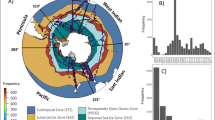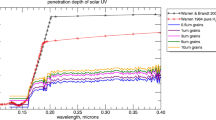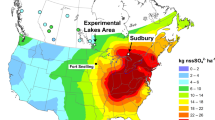Abstract
Natural levels of ultraviolet (UV) radiation can harm organisms inshallow aquatic ecosystems in which concentrations of photo-protective dissolved organic carbon are low1,2,3. These compounds can be removed as a result of acidic precipitation and climate changes, an effect which may have recently been manifested in up to 200,000 boreal lakes4,5. Unfortunately, meteorological and biological monitoring studies are usually too brief to record the magnitudes of past changes in UV radiation fluxes and their effects. Here we demonstrate that certain fossil pigments in lake sediments can be used to document historical changes in the UV radiation environment of lakes. These pigments are produced by benthic algae when exposed to UV radiation and show sedimentary concentrations that are correlated to the depth of penetration of UV radiation within lakes. Analysis of fossil profiles from the sediments of two mountain lakes suggests that past UV radiation penetration has sometimes been—at least in these mid-latitude lakes—greater than during the period of anthropogenic stratospheric ozone depletion.
This is a preview of subscription content, access via your institution
Access options
Subscribe to this journal
Receive 51 print issues and online access
$199.00 per year
only $3.90 per issue
Buy this article
- Purchase on Springer Link
- Instant access to full article PDF
Prices may be subject to local taxes which are calculated during checkout


Similar content being viewed by others
References
Bothwell, M. L., Sherbot, D. & Pollock, C. M. Ecosystem response to solar ultraviolet-B radiation: Influence of trophic-level interactions. Science 265, 97–100 (1994).
Karentz, D. et al. Impact of UV-B radiation on pelagic freshwater ecosystems: Report of working group on bacteria and phytoplankton. Arch. Hydrobiol. 43, 31–69 (1994).
Siebeck, O. et al. Impact of UV-B radiation on zooplankton and fish in pelagic freshwater ecosystems. Arch. Hydrobiol. 43, 101–114 (1994).
Schindler, D. W., Curtis, J. P., Parker, B. R. & Stainton, M. P. Consequences of climate warming and lake acidification for UV-B penetration in North American boreal lakes. Nature 379, 705–708 (1996).
Yan, N. D., Keller, W., Scully, N. M., Lean, D. R. S. & Dillon, P. Increased UV-B penetration in a lake owing to drought-induced acidification. Nature 381, 141–143 (1996).
Fritz, S. C., Juggins, S., Battarbee, R. W. & Engstrom, D. R. Reconstruction of past changes in salinity and climate using a diatom-based transfer function. Nature 352, 706–708 (1991).
Douglas, M. S. V., Smol, J. P. & Blake, W. J Marked post-18th century environmental change in high Arctic ecosystems. Science 266, 416–419 (1994).
Leavitt, P. R. Areview of factors that regulate carotenoid and chlorophyll deposition and fossil pigment abundance. J. Paleolimnol. 9, 109–127 (1993).
Garcia-Pichel, F. & Castenholtz, R. W. Characterization and biological implications of scytonemin, a cyanobacterial sheath pigment. J. Phycol. 27, 395–409 (1991).
Karentz, D., McEuen, F. S., Land, M. C. & Dunlap, W. C. Survey of mycosporine-like amino acid compounds in Antarctic marine organisms: Potential protection from ultraviolet exposure. Mar. Biol. 108, 157–166 (1991).
Leavitt, P. R., Schindler, D. E., Paul, A. J., Hardie, A. K. & Schindler, D. W. Fossil pigment records of phytoplankton in trout-stocked alpine lakes. Can. J. Fish. Aquat. Sci. 51, 2411–2423 (1994).
Scully, N. M. & Lean, D. R. S. The attenuation of ultraviolet radiation in temperate lakes. Arch. Hydrobiol. 43, 135–144 (1994).
Vinebrooke, R. D. & Leavitt, P. R. Effects of ultraviolet radiation on periphyton in an alpine lake. Limnol. Oceanogr. 41, 1035–1040 (1996).
Blumthaler, M. & Ambach, W. Indication of increasing solar ultraviolet-B radiation flux in alpine regions. Science 248, 206–208 (1990).
Caldwell, M. M., Robberecht, R. & Billings, W. D. Asteep latitudinal gradient of solar ultraviolet-B radiation in the arctic-alpine life zone. Ecology 61, 600–611 (1980).
Baron, J., McKnight, D. & Denning, A. S. Sources of dissolved and particulate organic material in Loch Vale watershed, Rocky Mountain National Park, Colorado, USA. Biogeochemistry 15, 89–110 (1991).
Morris, D. P. et al. The attenuation of solar UV radiation in lakes and the role of dissolved organic carbon. Limnol. Oceanogr. 40, 1381–1391 (1995).
Anderson, R. S. Crustacian plankton communities of 340 lakes and ponds in and near the national parks of the Canadian Rocky Mountains. J. Fish. Res. Board Can. 31, 855–869 (1974).
Leavitt, P. R. & Findlay, D. L. Comparison of fossil pigments with 20 years of phytoplankton data from eutrophic Lake 227, Experimental Lakes Area, Ontario. Can. J. Fish. Aquat. Sci. 51, 2286–2299 (1994).
Mantoura, R. F. C. & Llewellyn, C. A. The rapid determination of algal chlorophyll and carotenoid pigments and their breakdown products in natural waters by reverse phase high-performance liquid chromatography. Anal. Chim. Acta 151, 297–314 (1983).
Proteau, P. J., Gerwick, W. H., Garcia-Pichel, F. & Castenholtz, R. W. The structure of scytonemin, an ultraviolet sunscreen pigment from the sheaths of cyanobacteria. Experimentia 49, 825–829 (1993).
Anderson, R. F., Schiff, S. L. & Hesslein, R. H. Determining sediment accumulation and mixing rates using 210Pb, 137Cs, and other tracers: Problems due to postdepositional mobility or coring artifacts. Can. J. Fish. Aquat. Sci. (suppl. 1) 44, 231–250 (1987).
Dixit, S. S., Dixit, A. S. & Smol, J. P. Lake acidification recovery can be monitored using chrysophycean microfossils. Can. J. Fish. Aquat. Sci. 46, 1309–1312 (1989).
Schindler, D. W., Ruszczynski, T. & Fee, E. J. Hypolimnetic injection of nutrient effluents as a method for reducing eutrophication. Can. J. Fish. Aquat. Sci. 37, 320–327 (1980).
Case, R. A. & MacDonald, G. M. Adendroclimatic reconstruction of annual precipitation on the western Canadian prairies since A.D. 1505 from Pinus flexilis James. Quat. Res. 44, 267–275 (1995).
Luckman, B. H. Mountain areas and global change: A view from the Canadian Rockies. Mount. Res. Dev. 10, 183–195 (1990).
Schindler, D. W. et al. Climate-induced changes in the dissolved organic carbon budgets of boreal lakes. Biogeochemistry 36, 9–28 (1997).
Schindler, D. W. et al. The effects of climatic warming on the properties of boreal lakes and streams at the Experimental Lakes Area, northwestern Ontario. Limnol. Oceanogr. 41, 1004–1017 (1996).
Goodwin, T. W. The Biochemistry of the Carotenoids Vol. 1 Plants (Chapman & Hall, London, (1980)).
Findlay, D. L. & Kasian, S. E. M. Phytoplankton communities of lakes experimentally acidified with sulfuric and nitric acids. Can. J. Fish. Aquat. Sci. 47, 1378–1386 (1990).
Acknowledgements
This work was supported by the Natural Sciences and Engineering Research Council of Canada.
Author information
Authors and Affiliations
Corresponding author
Rights and permissions
About this article
Cite this article
Leavitt, P., Vinebrooke, R., Donald, D. et al. Past ultraviolet radiation environments in lakes derived from fossil pigments. Nature 388, 457–459 (1997). https://doi.org/10.1038/41296
Received:
Accepted:
Issue Date:
DOI: https://doi.org/10.1038/41296
Comments
By submitting a comment you agree to abide by our Terms and Community Guidelines. If you find something abusive or that does not comply with our terms or guidelines please flag it as inappropriate.





